Consumers split over impact of Nike’s Colin Kaepernick campaign
New data shows that younger consumers and those who are Asian or Black/African American are far more likely to view the campaign favourably than older, white consumers, and it is more likely to get them to buy from Nike in the future.
 US and UK consumers are split over the impact of Nike’s Colin Kaepernick campaign, with younger people and those who are Asian or Black/African American far more likely to view the campaign favourably than older, white consumers.
US and UK consumers are split over the impact of Nike’s Colin Kaepernick campaign, with younger people and those who are Asian or Black/African American far more likely to view the campaign favourably than older, white consumers.
Data from YouGov BrandIndex shows the campaign has certainly garnered attention among consumers in the UK. Its Attention score, which measures if respondents have heard anything about a brand, has gone from around +9 just before the ad launched to +28 yesterday (11 September).
Its Word of Mouth score, which measures whether people are talking about a brand, is also up from +9 to +17, while its Buzz scores, which is a balance of whether what they have heard is positive or negative is up from +6 to +10.
“YouGov’s BrandIndex data underlines the immediate impact that the campaign has had, with Nike generating attention that very few brands are able to match,” says Amelia Brophy, head of brands at YouGov.
In a survey of 1,000 US consumers commissioned by Marketing Week and conducted by Toluna, overall people are split on the impact of the campaign. When asked whether they had heard mostly positive or negative comments about the ad, 31% say they’ve heard “mostly” or “overwhelmingly” positive comments, compared to 45% who have heard “mostly” or “overwhelmingly” negative responses.
And in response to a question on whether the campaign had made them think differently about Nike, 33% say they now view the brand more favourably and 30% less favourable, while 37% says it’s had no impact. There is a similar split for whether it impacted their likelihood to buy Nike products, with 28% saying they would buy more, 26% that they would buy less and 46% saying it would not affect their propensity to purchase.
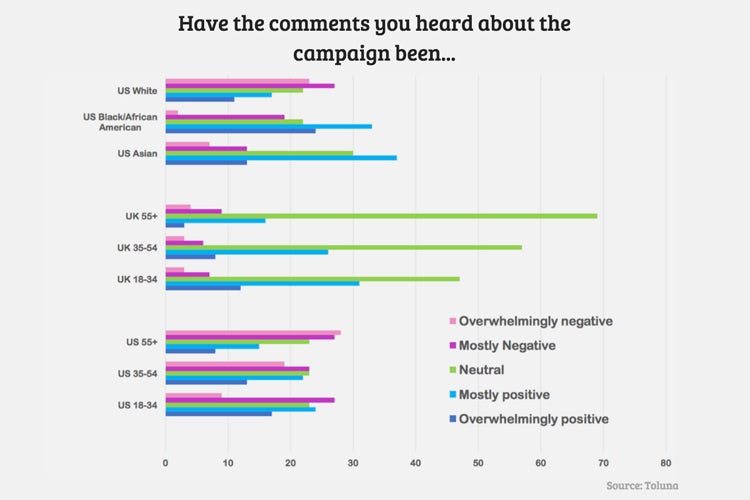
In a separate study of 1,000 UK consumers conducted by Toluna for Marketing Week, while fewer respondents have heard about the campaign it has had a more positive impact on those who have. Some 31% say comments have been mostly or overwhelming positive, with just 11% saying they have seen mostly or overwhelmingly negative comments.
And while the campaign is less likely to make people think differently about the brand in the UK or buy more of its products – 63% and 70% of people answered no to theses questions respectively – 30% say it will make them view the brand more favourably and 24% say they will buy more Nike products as a result. Just 7% now view Nike less favourably and 6% will buy fewer Nike products.
Has the targeting worked?
However, the overall responses only tell a certain story about the impact of the campaign. People’s reaction to it varies markedly based on key demographics such as age and ethnicity. And the data suggests Nike’s targeting has worked.
By featuring Kaerpernick in its campaign, Nike has created positive buzz and impact from an audience of younger consumers, those who are more left wing and those from the BAME community. And the survey shows these people are also more likely to be Nike customers.
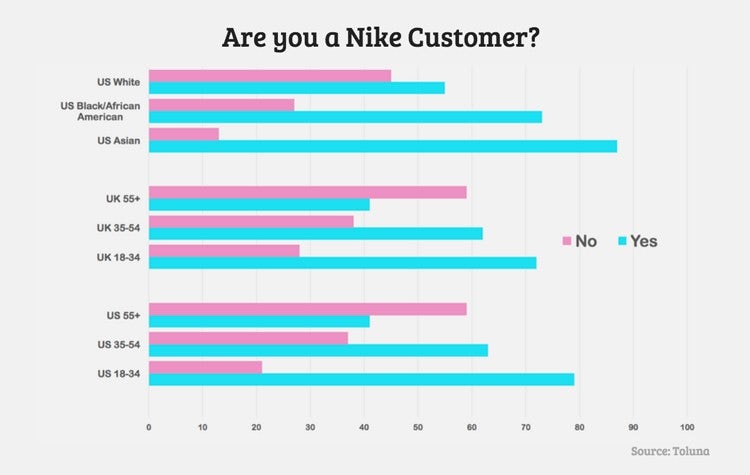
According to Toluna, 79% of those aged 18 to 34 in the US are Nike customers, compared to 63% among the 35 to 54 age group, and 41% among the over-55s. They are also much more likely to support NFL players taking the knee during the national anthem, to think that brands in general should take a political stance and that Nike specifically is the sort of brand that should take a stand on political issues.
This flows through in the results. Some 41% of those aged 18 to 34 say the comments they have heard about the campaign are “mostly” or “overwhelmingly” positive. This compares to 35% of those aged 35 to 54 and 23% of the over-55s.
Respondents aged 18 to 34 are also more likely to say the campaign has positively impacted their opinion of Nike, with 50% now viewing it more favourably compared to 14% that view it less favourably. And it has positively impacted their propensity to buy Nike products, with 49% saying they will buy more versus the 9% saying they will buy less.
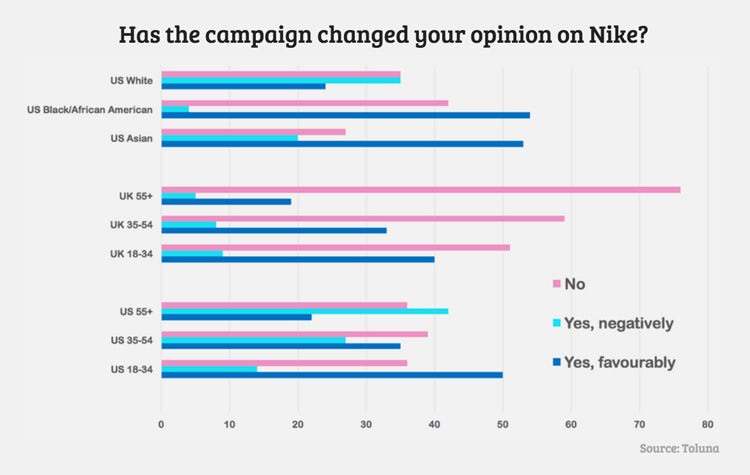
In comparison, just 22% of those aged over 55 now think more favourably about Nike, versus 42% that now view the brand less favourably. Plus, 14% say they will be more likely to buy Nike products after seeing the campaign, versus 27% say they will be less likely to.
There is a similar pattern when looking at ethnicity in the US. Asian and Black/African American respondents are more likely to be Nike customers than white consumers and more likely to have seen mostly positive comments about the campaign, to view Nike more favourably and to buy more products from Nike.
In the UK, the disparity is less pronounced, with the campaign overall less likely to have impacted consumers’ perceptions of the brand. But there is still clearly a trend in the data for younger consumers to view it more favourably than older.
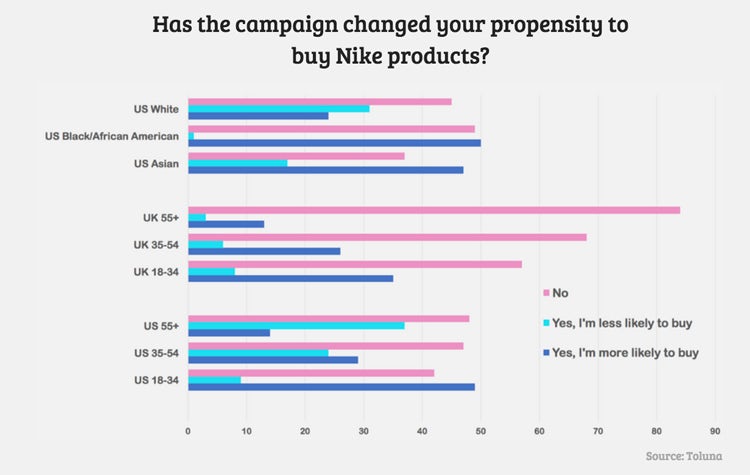
And according to the YouGov data, while Nike’s Impression score is +45 among those aged 18 to 34, (up from +34 before the campaign launched), it is just +36 among those aged over 55.
“Nike’s brand metrics have improved most among consumers that are aged 18 to 34. Our results suggest that Nike is successfully speaking to its target audience – the future of sportswear spend is this younger demographic – and that it is willing to antagonise older more conservative people to ensure its message cuts through.
“Importantly, our Profiles data shows that those who already shop at Nike are more likely than the average person to have a positive impression of Kaepernick.”
The big question is whether the improved favourability among its target demographic is enough to offset the negativity of the other half.
As Marketing Week columnist Mark Ritson puts it: “Nike wins big on brand positioning with this campaign. But it loses half on targeting. In that sense it’s one of the boldest branding plays of the year. The big question is whether the massive surge in notoriety, salience, revitalisation and meaning across half Nike’s market will offset the negativity among the other half.”

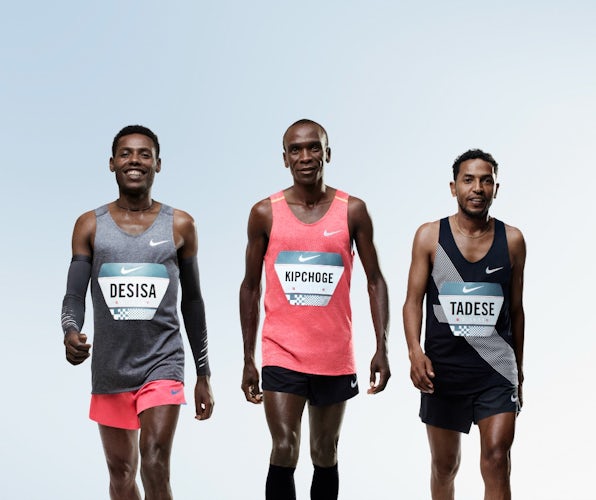






The campaign is working. Don’t like it myself, because it’s deliberately divisive and I think that’s bad for society (I’m not commenting on the merits of the issues), but it’s clearly the right move in pure economic terms. In the long term, the risk they are taking is that young people often reject radicalism as they grow up. https://www.fool.com.au/2018/09/14/nike-share-price-reaches-all-time-high-on-the-back-of-controversial-campaign/
Targeting younger people by knowing that they support more radical moves is clever on Nike’s part. In response to saying that Nike’s move is deliberately divisive, there will always be divided amongst older and younger generations and that is what this comes down to. Older generations do not consume at the level of a younger person and they also do not buy Nike, for the most part. Nike knows that most of their customers are younger and they will always make moves to appeal to the younger crowd.
Nike’s campaign with Kaepernick is working in my opinion. Nike’s focus on targeting the younger generation of consumers, researching where they stand with the NFL knee situation and understanding what stance the bulk of their current customers take on the situation stands out to me. This was a very bold marketing campaign by Nike and one that took a decent amount of research on the views of the rising, younger consumers. Most of the youth already supported the taking of a knee in the NFL, something Nike knew, they also knew that those who did not support the knee movement where of a certain age and race that already did not buy Nike products. Fitness gear appeals to the younger generations naturally, the fitness lifestyle is on the rise and most people live an active life now compared to those from previous generations who did not grow up under the influence of the fitness take over. My opinion on the knee movement does not match those who are for or against it but my view on Nike is more positive now though, not because they support the knee movement but because they are not afraid to make a bold move and are not afraid to upset a mass of people.